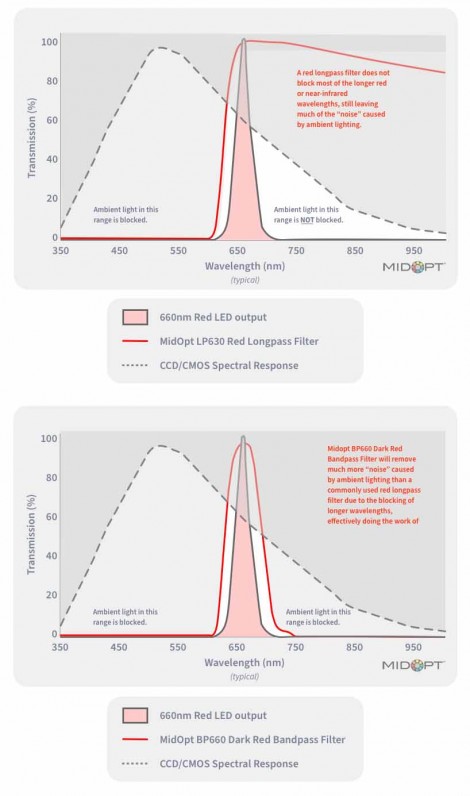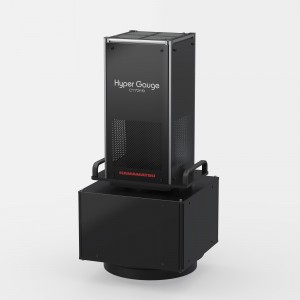
When developing a machine vision application, having the correct lighting to achieve maximum contrast is extremely important. Improper lighting can cause even the most advanced system to run slow or to have a high number of false rejects or accepts. Machine vision filters also play an important role in ensuring an application runs smoothly.
Relative to lighting equipment, optical filters are far less expensive, easier to obtain, and can produce significantly better results. In many cases, it makes sense to test optical filters before ordering lighting hardware. However, many are unsure what the best filter for their system may be or where to begin.
Instead of testing different colors of LED lighting, placing a filter in front of the camera lens provides a quick way to determine whether a desired effect will occur. MidOpt Bandpass Filters are designed to emulate the output of the most commonly used LED wavelengths in machine vision. By using white light and a MidOpt Bandpass Filter, you can easily determine the proper wavelength for your application. (Figure 1)

We recommend starting with a machine vision filter kit such as the MidOpt FK200, which includes the ten most often recommended ultraviolet (UV), visible (VIS) and near-infrared (NIR) machine vision filters. The filters come assembled in a 27mm filter mount, and the kit includes a M25.5 and M30.5 step adapter to accommodate the three most common lens filter mount sizes in machine vision.
Filter types
In color applications, complementary colors form the most dynamic contrasts. The same is true when monochrome cameras are used. But when using color filters, results are seen in black, white and varying shades of gray. Optimum contrast between two subjects can provide a very white and very black hue within the same scene, accomplished by maximizing the amount of light transmitted in at least one wavelength range and minimizing the amount transmitted, or attenuated, in another range. (Figure 2)

For example, to brighten or highlight a subject that is predominantly blue, transmission in the blue portion of the spectrum must be maximized, and the green, yellow, red and other portions of the spectrum blocked. “Color” filters attenuate light within a portion of the VIS spectrum and have an obvious color. These filters can be categorized as Shortpass, Longpass and Bandpass Filters.
Shortpass, longpass and bandpass filters
Shortpass Filters pass shorter wavelengths of light, while blocking longer wavelengths. Longpass Filters do the opposite, passing longer wavelengths and blocking shorter wavelengths. These filters are usually identified by their 50% points, the point where 50% of the light is being transmitted and 50% is being blocked – a halfway point in the transition from blocking to transmitting, or vice versa.
A red 630nm Longpass Filter, like MidOpt LP630, may be a great choice for applications using a 660nm LED or structured laser diode lighting. It blocks lower wavelength light, has a 50% point at 630nm and has very high transmission at 660nm and beyond. The LP630 Longpass Filter would not be suitable for use with 630nm LEDs.
In order to achieve maximum contrast, 100% transmission at 660nm is desirable, while most of the ambient light should be completely blocked, with as sharp of a cut-on and cut-off as possible. To the human eye, the LP630 may appear to be a good filter choice, but most CCD/CMOS cameras have excellent near-infrared (NIR) sensitivity, and considerable near-UV sensitivity as well. Many of these cameras have sensitivity that peaks in the NIR.
When a graphic representation of a typical CCD/CMOS spectral response curve is superimposed on the filter’s transmission curve, we can see that the LP630 does not block as much of the light to the camera as one might imagine (Figure 3). Slightly more than half of the extraneous light that the camera is sensitive to is being blocked. Because of this, MidOpt recommends using a broad Bandpass Filter for these types of applications, such as our BP660 filter.

Bandpass Filters are named according to the central or peak wavelength it transmits and will block longer and shorter wavelengths, resulting in improved contrast and better control over changes that may occur over time in ambient lighting conditions. For Bandpass Filters, ‘‘broad’‘ is necessary in most machine vision applications because this allows for variations in the spectral characteristics of the LEDs or laser diodes.
When choosing a Bandpass filter for a machine vision application, it’s important to choose one that’s stable (less sensitive to angle of incidence), consistent in performance and one that utilizes premium anti-reflection coatings to maximize the amount of transmission entering the vision system. (Figure 4)

All MidOpt Bandpass Filters have a hard, multi-layer anti-reflection coating that is optimized for the wavelength it’s intended for. They’re designed with StablEDGE® technology to lessen the effect of angle of incidence, and their passband is Gaussian shaped to emulate the output of the LED. All MidOpt filters are 100% inspected to ensure performance and repeatability – necessary for a robust vision system.
Polarizing filters
Light reflected from a non-metallic surface such as glass, lacquer, plastic or liquid results in polarization of the reflected light. Polarized reflected light can be the result of uncontrolled ambient light, but is more often from the light source. As the angle of incidence of the light and the camera relative to the subject are about the same and approach 55° to normal, a “glare” and loss of contrast becomes more pronounced.
In situations where the subject is partially obscured by this unwanted reflection, using a polarizing filter can reduce or eliminate this problem (Figure 5). 
Polarizing filters can also highlight stress patterns in clear plastic or glass to determine whether glass has been properly tempered.
Neutral density filters
In conditions where lighting is extremely bright, Neutral Density Filters can be essential. They generally appear gray in color and reduce the amount of light reaching the sensor without effecting color balance or contrast. They range from an optical density (OD) of 0.30 (MidOpt ND030), which transmits about 50% of visible light to OD 1.20 (MidOpt ND120), which transmits about 6.25% of visible light. In addition, Polarizing Filters can also function as Neutral Density Filters, with an OD of 0.50 (MidOpt PL032), transmitting about 32% of available light.
In machine vision applications, another common use for Neutral Density Filters is to decrease the depth of field by allowing wider lens apertures to be used. This helps separate subjects from their foreground and/or background as the subject will appears in focus, while the background will be out of focus. In situations involving bright ambient light, or when cameras must be directed at high intensity beams, such as automotive headlamps, Neutral Density Filters reduce the amount of light captured by the CCD/CMOS imager. (Figure 6)

IR & UV
Working in the NIR or UV spectrums offer significant advantages. Contrast in the NIR can be greatly improved depending on the characteristics of the item under inspection. 50% of the information captured in NIR images is significantly different when compared to those images captured with white light. This “50% rule” can apply to any given type of subject.
Unfortunately, it’s often impossible to tell how an image will appear in the NIR without experimentation. Fortunately, most CCD and CMOS cameras have excellent near-IR sensitivity, so tests can be performed quickly and easily by slipping a visible-blocking/IR pass filter over the camera’s lens. When a difference appears, filters can provide optimum separation between a subject and background (Figure 7).

In UV applications, 99% of inspections are not performed in the UV. These applications use UV or shorter wavelength lighting to excite a part or material under inspection. This material then emits light, usually somewhere in the visible portion of the spectrum. This fluorescence can often be weak and difficult to image. For such applications, a visible Bandpass Filter that’s appropriate for the emission wavelength is recommended. This Bandpass Filter should provide maximum transmission over the given wavelength range and block as much of the rest of the ambient light as possible – particularly the UV portion of the spectrum being emitted by the light source. With the use of CMOS cameras becoming widespread, a larger number of cameras now have significant UV sensitivity. (Figure 8)

Reducing the effects of extraneous light can significantly improve contrast and speed up or improve the accuracy of the machine vision inspection. In cases where there may be short- or long-term changes in ambient lighting, optical filters can also provide insurance that the results obtained by the machine vision system will not be affected.
Written by Barry Warzak, Founder Midwest Optical Systems































 Back to Features
Back to Features



























